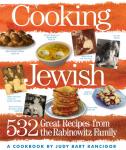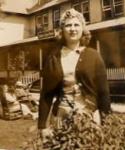
BUY COOKING JEWISH by clicking here now.
Something old and something new for the holiday
By JUDY BART KANCIGOR
The Orange County Register
September 17, 2009
RECIPES:
Chicken Casserole with Dried Fruit on a Bed of Couscous
Apple, Cinnamon and Walnut Cake
An old saying goes, ask two Jews a question and you'll get three opinions.
Controversy, controversy. In politics you expect it, but it's true even in
cooking.
Take the much maligned, yet oh, so beloved Jewish appetizer that graces
every holiday table from the weekly celebration of the Sabbath to Rosh Hashana,
the Jewish New Year: Gefilte fish.
In the Middle Ages Jewish mystics viewed fish as signaling the coming of the
Messiah. No wonder it is served for every holiday. Fish was expensive in
Europe, and the recipe was developed as an economical way to stretch it so that
every family member could get a taste.
The word gefilte is actually German for "stuffed." The original
recipe called for seasoned, ground boned fish mixed with eggs and fillers, such
as vegetables and crumbs, which was then stuffed back into the fish skin and
cooked. Over the centuries, the skin was eliminated, with cooks shaping the
mixture into balls or patties and poaching them.
But wherein lies the controversy? Do we open a jar or make it ourselves…or
"doctor" the jarred variety? Do we like it sweet or peppery? With
some guests adoring it and others repelled at the very sight, do we even serve
it at all?
Can she bake a rhubarb pie, Billy Boy, Billy Boy?
I don’t come from a long line of pie bakers. I don’t think my grandmother, Mama Hinda, ever baked one…I know my mother never did. Yet to my mind as a young bride, nothing epitomized consummate homemaking skills as much as the baking of pies, something I would not even attempt for decades.
For many years I lived with a dough phobia, the result of a kitchen disaster I call the “kreplach incident.” I had rolled out the dough for these little meat-filled dumplings, carefully placed them in boiling water and they exploded! That experience created a fear of all things rolled that spilled over to piecrusts and pastries and lasted over thirty years.
Although in the ensuing years I rolled cookie dough and turned out homemade knishes by the dozens with ease, somehow pie baking I thought of as a magical gift bestowed from birth on some, but never to be attained by others. Genetics, perhaps?
“I’m just not a dough person,” I would lament… until testing recipes for my cookbook forced me to face my fears (and without a support group). Recipes needed to be tested. I cooked. I baked. I even perfected the dreaded kreplach! The pies I left for last.
Finally, in an “Aha!” moment of the kitchen kind, I realized…I roll cookie dough, I roll knish dough. Now I even roll kreplach dough! Surely I can roll pie dough.
Enter cooking instructor Barbara Shenson, whom my daughter-in-law Tracey met when Shenson was teaching for Home Chef, a cooking school and store in San Francisco. Her pie-making tips put that last notch in my belt.
“My crust always shrinks,” I whined. Read the whole story.
Summer's here - how about some ice cream?
You adored it as a kid, but you’ve never outgrown it. Here are two words that make everyone’s eyes light up – ice cream!
“In the store-bought category there’s good, not so good and really bad,” said food writer and consultant Peggy Fallon, author of “The Best Ice Cream Maker Cookbook Ever” (HarperCollins) from her Northern California home. Ice cream maker? Do I need yet another unused appliance taking up space on my counter, I wondered.
Then I leafed through the book and I was smitten. Chocolate Pumpkin with Hazelnuts. Peaches ‘n’ Cream. Double Ginger. Utterly Peanut Butter with a whole cup of peanut butter in a quart of ice cream! But with so many even gourmet ice creams available today, why would I want to make my own?
“I think the appeal of homemade ice cream, sorbets and frozen yogurts is that you control what goes into them,” Fallon noted. “There are so many odd ingredients in most supermarket ice cream. Just look at the labels. When you make your own, you use real cream, eggs, sugar and milk. If you’re concerned about what you put into your body, it’s better to eat real food.”
Sounds great, but I’m thinking, remember that bread machine you couldn’t live without and the havoc it played with your waistline?
Then I read on. A chapter called “On the Lighter Side” offers mouthwatering light ice creams, frozen yogurts, granitas and sorbets with alluring titles such as Maple Crunch Light Ice Cream, Tangy Orange Iced Buttermillk, Honey Vanilla Frozen Yogurt and Pear Sorbet with Zinfandel and Fresh Basil. Read the whole story
Cooking with Chef Christian Mailloux
Remember the movie “If It’s Tuesday This Must Be Belgium”? That was my life for the past few weeks when my book tour brought me to South Florida where I had 13 gigs in 11 days.
The highlight was my cooking demonstration at the KitchenAid Culinary Center at Robb & Stucky Patio, a chichi furniture store in Palm Beach Gardens offering cooking classes in its fully stocked, state-of-the-art professional kitchen.
The event was sponsored by the Jewish Community Center of the Greater Palm Beaches, and here are the four dishes I taught that evening – Layered Hummus and Eggplant Appetizer, Yemenite Haroset Truffles, Malaysian Latkes and a flourless chocolate cake we call Too Good to Call Passover Cake Bete Noire.
But enough about me!
The Center’s Chef Christian Mailloux, a graduate of the Culinary Institute of America in Hyde Park, New York, generously turned his kitchen over to me for the night, but more importantly, his services as sous-chef!
“I’ve been interested in cooking since I was a child, watching my mom and dad,” Mailloux told me as he chopped my onions in preparation for the class.
Mailloux’s grandparents and great-grandmother were from the Azores, and he grew up with the Portuguese cuisine of his mother’s family and the French of his father’s.
“There was always some sort of French-Portuguese dish floating around,” he recalled, “veal braised in tomato sauce, Portuguese sweet bread, cured olives. My brother and I would run around the house with an olive on every finger.”
A traditional Purim feast brought up to date
My column at OU's ezine "Shabbat Shalom" features the following recipes from Jayne Cohen's "Jewish Holiday Cooking": Chickpeas with Garlic and Barbeque Spices, Poached Prune Kreplach with Honeyed Cream and Pecans, Mishmash Kreplach (Beef, Potato and Fried Onion Kreplach). You'll find them at the end of the story.
When Jayne Cohen and her sister returned home after their grandmother had passed away, they were determined to recreate the holiday dishes they had grown up on. But neither had ever attempted these traditional recipes. Those had been Grandma’s province. Read the entire story.
BETTER HOMES AND GARDENS
The March issue of Better Homes and Gardens features three Passover recipes from Cooking Jewish: Apricot Squares, Chocolate Macaroons and Flourless Chocolate Cake. See pages 160 and 162 and enjoy!
Have you got a shiterein story for me?
Okay, before you have me arrested, I’m not cursing here.
Shiterein (Yiddish): v. to add an unspecified amount adj. describing one who cooks from experiece and touch without recipes or measuring
Our foremothers were shiterein cooks. Who needs to measure? You throw in a little of this, a little of that, and a wonderful dish emerges. Far from haphazard, it’s a style borne of experience, confidence, instinct, and skill.
Shiterein cooks don’t usually write down their recipes. Fortunately Aunt Sally recorded my grandmother’s recipes or I wouldn’t have them. When they do write them down, they provide rather quirky measurements and instructions:
“a glass flour” or “a gluzzela” (little glass)
“an eggshell water”
“2 cents yeast”
“a nice piece of veal”
“knead until it feels right”
and of course the ever popular: “cook until done”
Aunt Hilda’s recipe for Chocolate Chip Mandelbrot ended this way: “If too sweet, next time add less sugar.”
Recently a friend told me that when she asked her mother when to put the dish in the oven, her response was, “So you’ll wake up a little earlier.”
Have you got a shiterein tale to tell? Would love to hear the instructions your foremothers left for you. Click "comments" below.
A harvest of recipes
My column at OU's Shabbat Shalom entitled A harvest of recipes for Sukkot 5768 features the following recipes: Spinach-Stuffed Acorn Squash, Stuffed Eggplant in Olive Oil with rice, pine nuts and currants, and Polish Apple Cake. Chag Sameach! And in keeping with the harvest season, here's my latest column in the Orange County Register:
Cooking at the farmers' market
The Orange County Register/Fullerton News Tribune
October 4, 2007
by Judy Bart Kancigor
Amelia Saltsman is on a mission. With a cooking demonstration and book signing a month away, she is trawling the farmers’ market, querying farmers as to availability. Will there be persimmons? How about pomegranates? I tag along for the ride.
“Because I work with seasonal ingredients, and we are now on the cusp of the change of seasons, I need to best guess with the farmers when things will become available,” explains Saltsman as we stroll down the aisles.
But there are frequent interruptions, because this is the Santa Monica Farmers’ Market and Saltsman – writer, cooking teacher, producer/host of her own TV show and author of “The Santa Monica Farmers’ Market Cookbook” – is the undisputed queen of this market and instantly recognized by shoppers and farmers alike.
Every grower greets Saltsman, who has immortalized them in her new cookbook, which is as much an homage to the farmers, their histories, and their commitment to excellence as it is a collection of fuss-less, original and artful recipes inspired by the amazing varieties they produce.
Slow-cooked green beans? YUM!
When I think back to my grandmother’s cooking, nothing green comes to mind. Beets, carrots, onions, radishes – those familiar vegetables of Eastern Europe graced her table in America as well. When I asked my mother if she could remember eating any vegetables when she was growing up, she said, “Sure. We had potatoes.”
Oh, I suppose you could say my grandmother had a Victory garden – if you can call winning the war against aphids a victory. She grew roses, not vegetables! Which is not to say she wasn’t fiercely patriotic. For my grandparents, proud to be American citizens, Election Day was a major event, requiring hours of preparation and wardrobe consultation. But my grandmother contributed to the war effort by rolling miles of bandages for the Red Cross, not by harvesting broccoli.
By the 1950s, when I was growing up, the Jolly Green Giant had cut a mighty swath across the land and convenience was in. My generation, however, remembers vegetables as a toll to be paid for crossing the bridge to the treasure on the other side, as in “Eat your vegetables and you can have dessert.” Or so I’m told. No one had to coax us to eat anything in our house.
Ahead of her time, my mother actually steamed a veggie or two. For company she’d present a gorgeous display: a whole head of cauliflower surrounded by bursts of red, green, and orange. But in truth, she did it more for presentation than nutrition. And as for the vegetables she served for family dinners, I suspect she was more concerned about filling us up low-calorically than she was about our vitamin consumption.
You Say Tomato, I Say Tomato: Recipes From Garden to Table
My latest column on OU's website includes recipes for Tomato Pie, Tomato and Cucumber Bread Salad and Classic Tomato Soup with a Goat Cheese Swirl. Enjoy!
Like its nightshade relatives, the eggplant and potato, it was once thought to be poisonous. The French named it pomme d’amour (love apple) and considered it an aphrodisiac. Really a fruit, it’s called a vegetable. Call the tomato what you want. I call it delicious.
According to John Cooper in “Eat and Be Satisfied,” tomatoes were brought to Europe from Mexico in the sixteenth century, but weren’t


